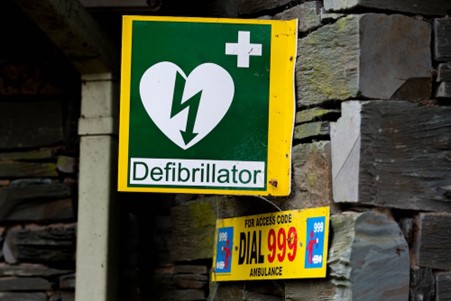Introduction
Many of us do not realise it but the importance of defibrillators and defibrillator training cannot be overstated. While Ireland is known for its beautiful landscapes and lively traditions, it is unfortunately also home to a significant number of individuals at risk of sudden cardiac arrest (SCA). The Irish Heart Foundation reported in 2021 that there were nearly 3,000 community cardiac arrests the previous calendar year. In such critical moments, defibrillators become invaluable lifesaving devices, offering a crucial advantage over traditional cardiopulmonary resuscitation (CPR). This article delves into the significance of defibrillators and being defibrillator trained for our communities, highlighting their many benefits compared to CPR.
We have also included a resources section for you at the end of this blog with further information and useful links.
Understanding Sudden Cardiac Arrest
Before we delve into the benefits of defibrillators, it is essential to understand what Sudden Cardiac Arrest is. Sudden Cardiac Arrest is a life-threatening condition wherein the heart suddenly stops beating unexpectedly, usually due to an electrical malfunction. Contrary to popular belief, SCA is not the same as a heart attack, although it can result from one. During SCA, the individual loses consciousness, stops breathing, and their pulse becomes unnoticeable. Without immediate intervention, SCA can lead to brain damage or death within minutes.
The Importance of Defibrillators
Rapid Response Saves Lives
Defibrillators are crucial in the race against time when it comes to SCA. Every minute that passes without defibrillation reduces the chances of survival by 10%. In rural areas or neighbourhoods far from medical facilities, having a defibrillator on hand can make the difference between life and death. Having a defibrillator accessible within the community ensures that critical help can be administered in those vital early moments while waiting for professional medical assistance to arrive.
User-Friendly and Safe
One of the greatest advantages of defibrillators is their user-friendliness. Modern defibrillators are designed to be straightforward and safe for anyone to use. They come with easy-to-follow instructions and voice prompts, making it possible for even those with no medical training to administer a life-saving shock effectively. This accessibility empowers bystanders to take action and potentially save lives before professional help arrives.
Enhanced Chance of Restoring Normal Heart Rhythm
The primary function of a defibrillator is to deliver an electric shock to the heart, which can help restore a normal heart rhythm. In the case of ventricular fibrillation, the most common cause of SCA, the heart’s electrical signals become chaotic, causing the heart to quiver rather than pump blood effectively. A defibrillator’s shock can interrupt this chaotic activity, allowing the heart to reset and hopefully resume normal function.
Comparing Defibrillators to CPR
While both defibrillators and CPR aim to save lives during SCA, there are crucial differences between the two, making defibrillators a preferred choice in many scenarios.
Effectiveness
CPR alone, while valuable, may not be as effective as defibrillation. CPR provides manual chest compressions and artificial ventilation, which can help maintain minimal blood circulation until professional help arrives. However, it does not address the underlying electrical issue causing SCA. Defibrillation, on the other hand, can directly address this issue, increasing the chances of restoring a normal heart rhythm significantly.
Speed of Intervention
Defibrillators can be deployed quickly and used immediately by bystanders. CPR, although essential, may take a few critical minutes to initiate and requires continuous, uninterrupted chest compressions. Defibrillators offer a faster and more direct response to the immediate problem – the chaotic heart rhythm – making them the preferred choice for many situations.
Accessibility
While CPR training is vital and recommended for all individuals, not everyone may be confident enough to administer it during an emergency. Moreover, performing CPR correctly requires proper training and regular practice. In contrast, defibrillators are designed to be user-friendly, with clear instructions and voice prompts, making them accessible to a wider range of people, including those without extensive medical training.
Consistency in Quality
CPR quality can vary significantly depending on the individual administering it. Factors such as the depth and rate of chest compressions and the effectiveness of ventilation can impact the outcome. Defibrillators, on the other hand, provide consistent and standardised care, ensuring that each shock is delivered accurately and with the appropriate force.
Recognising Sudden Cardiac Arrest
Recognising the signs of sudden cardiac arrest and distinguishing it from a heart attack is crucial for timely intervention. To differentiate between the two, focus on the following key distinctions:
Symptoms: SCA typically presents with an immediate loss of responsiveness, absence of breathing, and a lack of pulse. On the other hand, a heart attack often involves chest pain, along with symptoms like shortness of breath, nausea, light-headedness, and pain radiating to the arm, jaw, or back.
Appearance: During SCA, the person may suddenly collapse and become unresponsive. In a heart attack, the individual is usually conscious and alert, albeit in distress.
Breathing: SCA victims don’t exhibit normal breathing, while those experiencing a heart attack often do. Gasping, irregular, or no breaths are signs of SCA.
Pulse: Check for a pulse at the carotid artery (neck) during SCA; it’s typically absent. During a heart attack, a pulse is present, but it may be weak or irregular.
Given these differences, if you encounter someone who suddenly collapses, loses consciousness, isn’t breathing normally, and has no pulse, it’s more likely SCA.
In such cases, call 911 (or your local emergency number), begin CPR if trained, and retrieve a nearby defibrillator if available. Rapid response is crucial in saving lives during sudden cardiac arrest, so knowing these signs and acting promptly can make all the difference.
Conclusion
In Ireland, our communities are known for their warmth, resilience, and spirit. It is our responsibility to safeguard the lives of our loved ones and neighbours by recognising the importance of defibrillators and defibrillator training. These lifesaving devices offer a rapid, user-friendly, and effective response to sudden cardiac arrest, significantly improving the chances of survival compared to CPR alone.
By promoting defibrillator awareness and training within our communities, we can empower ordinary citizens to become extraordinary lifesavers. Every defibrillator installed in public spaces, workplaces, and homes is a beacon of hope, a symbol of our commitment to preserving life in the face of adversity.
Let us embrace this essential technology, equip ourselves with the knowledge and skills needed to use it, and together, let us continue to make Ireland a safer place for all its inhabitants. After all, in the Emerald Isle, where every smile is a welcome invitation, every life saved is a cherished victory.
Resources
We have compiled a list of resources for you here related to defibrillators, defibrillator training, and more information on sudden cardiac arrest in Ireland:
Irish Heart Foundation (IHF):
- Website: irishheart.ie
- IHF provides comprehensive information on sudden cardiac arrest, CPR training, and the importance of defibrillators. They also offer courses on CPR and AED (Automated External Defibrillator) training.
Irish Red Cross:
- Website: redcross.ie
- The Irish Red Cross offers first aid and CPR courses, including AED training, to help individuals become more prepared for emergencies.
National Ambulance Service:
- Website: nas.ie
- The National Ambulance Service in Ireland provides valuable information on emergency medical services, including guidelines on how to recognise and respond to sudden cardiac arrest.
Community First Responder Ireland:
- Website: cfr.ie
- CFR Ireland is a network of community first responders who are trained to provide initial care in medical emergencies, including using defibrillators.
Health and Safety Authority
- Website: hsa.ie
The HSA offers guidance on workplace safety, which may include information on AED placement and training requirements in occupational settings.
Local Fire Station and Community Centres:
Many local fire stations and community centres in Ireland may offer CPR and AED training courses. Contact your local authorities to inquire about training opportunities in your area.
Irish Government Health Agencies:
Check the official websites of health agencies in Ireland, such as the Department of Health and the Health Service Executive (HSE), for resources and guidelines related to cardiac health and AED programs.
AED Locator Apps:
Consider downloading mobile apps that help you locate nearby defibrillators in case of an emergency. Apps like “AED Locator Ireland” can provide you with real-time information on the closest AEDs. You can find it on the App Store here or the Google Play Store here.
Local Organisations and Venues:
- Many local community organisations, sports clubs, and schools may have AEDs on their premises. Inquire with these groups about the availability of AEDs and whether they offer training sessions.
Remember that being prepared and educated about sudden cardiac arrest and defibrillators can make a significant difference in saving lives.
Regular training and awareness are key elements in ensuring a safer and more prepared community in Ireland.
Connect with us
To begin starting care for your loved one, you can click here.
To join our incredible award-winning team, you can apply now by clicking here or emailing your CV to recruitment@comfortkeepers.ie




